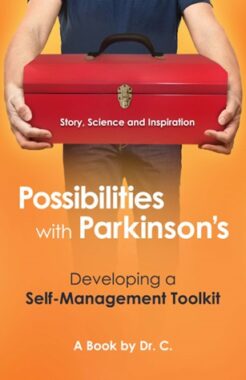Our self-management skills for Parkinson’s, now in book form
As the 'Possibilities with Parkinson's' column ends, another version begins its life

You can’t walk around with a doctor in one pocket and a therapist in the other. In fact, you can’t even walk around with your hands in your pockets if you have Parkinson’s disease because you need them to prevent you from bumping into things and falling. Nobody can be there 24/7 to prevent falls caused by Parkinson’s.
That’s where self-management plays a vital role — not just in preventing falls, but also in reducing the impact of many Parkinson’s symptoms. After several years of research and writing, Mrs. Dr. C and I are pleased to announce the publication of our most recent book, “Possibilities with Parkinson’s: Developing a Self-Management Toolkit” (Atmosphere Press).

The cover of Dr. C’s new book. (Courtesy of Dr. C)
The book, published last week, is a treasure trove of strategies for patients and caregivers with Parkinson’s. The hardcover edition will be out in mid-May.
In it, we start with the idea that Parkinson’s is first a brain disease and second, a movement disorder. The focus is first on retraining the brain. When one learns to deal with Parkinson’s disease by doing that and developing workarounds, the result is a pronounced lessening of the impact of symptoms.
Retraining the brain after an injury requires redirecting mental resources. This sustained, focused attention, shifted in new directions to address Parkinson’s symptoms, constructs new neural pathways around the damaged brain regions.
Getting started
The book is personally tailored to help readers shift to new thought patterns. We each have a unique brain; thus, this book is not a cookbook. It instead offers suggestions to help you design what works best for your life, your unique brain.
Parkinson’s can be annoyingly intrusive and nagging, and it never lets up. It progressively gets worse. There’s no cure at this time, and nothing can be done to make it go away.
That’s a gloomy picture, and too many writers leave the reader stranded in that desolation. But you don’t have to feel hopeless anymore. You now have a toolkit to retrain your Parkinson’s brain and cast off the shroud of despair.
The most difficult part of retraining the Parkinson’s brain is getting started — making that initial shift from the old ways to the new ones. It also takes a lot of time for the new brain patterns to be reliable, so you can count on them to help alleviate symptoms.
The toolkit does not sugarcoat the challenges of retraining the Parkinson’s brain. There’s no shortcut, no easy fix. Because it’s both difficult and time-consuming, there will be lots of failure. This just adds another layer of effort to what’s already the arduous task of living with Parkinson’s. Finding a way around the Parkinson’s brain damage requires the practice of retraining the brain throughout the day. The toolkit offers a map, but each person must walk their own rehabilitation path.
If you get the book, I recommend taking your time to read the instructive material. The book contains short essays. You can read an essay or two, put the book down, and then reflect on what you just read. Spend time processing the material and think about how you can fit it into your own life. Then try it out.
The goal is to build your own personally tailored toolkit, one that improves your life with Parkinson’s. Don’t just read the book; practice it. A toolkit is of little use if it just sits in the garage.
As a final recommendation, I suggest that you talk about the book with others. Do this in support groups, on the internet, with family, and with care providers. Don’t just say, “I found this great book.” Instead, talk specifically about how the toolkit is helping you personally. Talk about things you don’t understand. Think of this discussion as part of practicing the toolkit, of firming up the new brain pathways so that they become more resilient.
The more you use the new pathways, think about them, and talk about them, the more stable they’ll become. You can call upon these pathways to help improve your life with Parkinson’s. You’ll be helping others do the same.
Farewell, for now
This is Dr. C’s final column with Bionews, the parent company of Parkinson’s News Today. Writing over five years of weekly columns has taught us how to live better with Parkinson’s disease and chronic pain.
In the next chapter of our lives, we plan to share that wisdom with a broader audience. We’re now jumping full time into the next book, which goes beyond Parkinson’s. It’s tentatively titled “Shifting: A Revolutionary Brain-Training Approach for Reducing Suffering.” It’s a book three decades in the making.
Reader input has kept us inspired, and the compassion and support for our writing is a gift we’ll always cherish. Thank you.
Note: Parkinson’s News Today is strictly a news and information website about the disease. It does not provide medical advice, diagnosis, or treatment. This content is not intended to be a substitute for professional medical advice, diagnosis, or treatment. Always seek the advice of your physician or another qualified health provider with any questions you may have regarding a medical condition. Never disregard professional medical advice or delay in seeking it because of something you have read on this website. The opinions expressed in this column are not those of Parkinson’s News Today or its parent company, Bionews, and are intended to spark discussion about issues pertaining to Parkinson’s disease.








Robert E. Morgenstern
Just learning some information about Parkinsons. Was diagnosed three years ago by a Physician who retired. He saw me once a year claiming that was all I needed. Hopefully his replacement will do better. My symptoms are slowly growing. I am still able to function my own.
Jerry Miller
thank you for your help!
Toni Pombo
How do I get this book?
Mike
Dr.C,
Your book ‘Possibilities with Parkinson’s has been a source of information and inspiration. I will get your new book quickly. Thank-you for the knowledge you have acquired and shared. Good luck to you and your wife on your future endeavors. Blessings, Mike